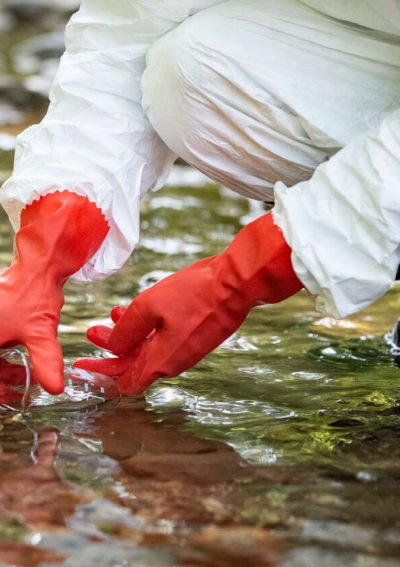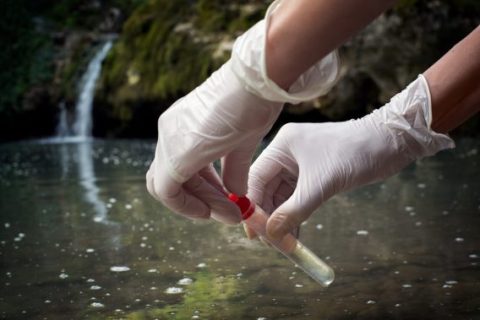Cancer from Camp Lejeune Water Contamination
Contaminated water at Camp Lejeune is linked to organ and blood cancers such as kidney cancer, breast cancer and leukemia. Veterans and family members who were exposed to the drinking water at Camp Lejeune from 1953 to 1987 may qualify for VA benefits.

Do the Chemicals in the Water at Camp Lejeune Cause Cancer?
The chemicals found in contaminated water at Camp Lejeune can cause a variety of cancers, according to the Environmental Protection Agency (EPA) and the Agency for Toxic Substances and Disease Registry (ASTDR).
Service members and civilians who lived and worked at Camp Lejeune from 1953 to 1987 were exposed to several toxic cancer-causing chemicals. These chemicals include known carcinogens trichloroethylene (TCE), perchloroethylene (PCE) also known as tetrachloroethene, vinyl chloride and benzene.

Of these chemicals, TCE is an especially potent carcinogen. ASTDR studies have shown it can cause kidney cancer, liver cancer and non-Hodgkin lymphoma in humans.
Studies show benzene can cause multiple myeloma and PCE can cause non-Hodgkin lymphoma. Data has also shown vinyl chloride exposure may lead to lung, brain and soft tissue cancer.
Camp Lejeune water plants had average TCE levels of 366 parts per billion (ppb), and the limit for TCE in drinking water is 5 ppb. TCE levels at the Hadnot Point water treatment plant were as high as 1,400 ppb.
Which Cancers Have Been Linked to the Water at Camp Lejeune?
Many studies have linked chemicals found in Camp Lejeune’s water to organ and blood cancer. Exposure to these chemicals doesn’t necessarily mean a person will get cancer, but the risk goes up with how frequent, how much and how long a person is exposed.
Researchers have linked higher death rates from at least twelve cancers specifically to contaminated water exposure at Camp Lejeune, according to an ASTDR study.
- Bladder cancer
- Breast cancer (in men and women)
- Cervical cancer
- Esophageal cancer
- Hodgkin lymphoma
- Kidney cancer
- Leukemia
- Liver cancer
- Multiple myeloma
- Pancreatic cancer
- Prostate cancer
- Rectal cancer
- Soft tissue cancer
The ASTDR study noted that Marines and Navy personnel stationed at Camp Lejeune from 1975 to 1985 had higher mortality hazard ratios for all cancers compared to those not exposed to contaminated water at Camp Pendleton.
Chances of Getting Cancer from Camp Lejeune Water
Marines and Navy personnel stationed at Camp Lejeune from 1975 to 1985 had a 10% increased risk of dying from any type of cancer compared to personnel at Camp Pendleton, according to the 2014 ASTDR study.
The study also found specific increased risks for kidney cancer, liver cancer, Hodgkin lymphoma and multiple myeloma, specifically.
- Kidney cancer: 35%
- Liver cancer: 42%
- Hodgin’s lymphoma: 47%
- Multiple myeloma: 68%
Service members and civilians living and working at Camp Lejeune were exposed to high levels of contaminants over a long period of time, greatly increasing their chance of getting cancer. As many as one million people could have been exposed to contaminated drinking water, according to ASTDR.
An individual’s chance of getting cancer from contaminated Camp Lejeune water depends on how long they were exposed, how they were exposed and their general health.
Which Cancers Are Eligible for VA Benefits?
The VA provides benefits for Camp Lejeune veterans and family members for nine types of cancer in addition to other health problems such as neurobehavioral effects. Family members only get reimbursement of out-of-pocket health care costs.
- Adult leukemia
- Myelodysplastic syndromes
- Bladder cancer
- Kidney cancer
- Liver cancer
- Multiple myeloma
- Non-Hodgkin lymphoma
Some cancers are eligible for VA disability benefits while others only qualify for out-of-pocket health care cost reimbursement.
- Bladder cancer
- Breast cancer
- Esophageal cancer
- Kidney cancer
- Leukemia
- Lung cancer
- Multiple myeloma
- Myelodysplastic syndromes
- Non-Hodgkin lymphoma
To qualify, veterans and family members must provide proof of service or living on base for at least 30 days from August 1953 to December 1987. Claimants also must have medical records that show diagnosis of any of one or more of the qualifying cancers.
Claimants can file a claim online on VA.gov, via mail or in person at a regional VA office.
What Should You Do If You’ve Been Diagnosed with Cancer?
If you’ve been diagnosed with cancer, it’s advisable to get a second opinion about your diagnosis and options for treatment. Discuss joining clinical trials for experimental treatment with your doctor. This may allow you to get more affordable and effective treatment for your cancer. Make sure you apply for all VA benefits that you qualify for, including disability and out-of-pocket health care cost reimbursement.
Unfortunately, cancer treatment can be expensive. Disability benefits a veteran receives don’t continue after death and may not help surviving family members and loved ones. Some people diagnosed with cancer after exposure to contaminated water at Camp Lejeune may qualify to file a lawsuit against the United States for compensation under the Camp Lejeune Justice Act of 2022, a part of the Honoring Our PACT Act of 2022.
The Justice Act passed the Senate in August 2022, and shortly after, President Biden signed it into law. If you want to file a Camp Lejeune lawsuit, make sure to speak to an attorney right away because there are time limits, and you could lose your right to file.
10 Cited Research Articles
Consumernotice.org adheres to the highest ethical standards for content production and references only credible sources of information, including government reports, interviews with experts, highly regarded nonprofit organizations, peer-reviewed journals, court records and academic organizations. You can learn more about our dedication to relevance, accuracy and transparency by reading our editorial policy.
- White House. (2022, August 10). FACT SHEET: President Biden Signs the PACT Act and Delivers on His Promise to America’s Veterans. Retrieved from https://www.whitehouse.gov/briefing-room/statements-releases/2022/08/10/fact-sheet-president-biden-signs-the-pact-act-and-delivers-on-his-promise-to-americas-veterans/
- The White House. (2022, June 16). Statement by President Joe Biden on Bipartisan Senate Passage of the PACT Act. Retrieved from https://www.whitehouse.gov/briefing-room/statements-releases/2022/06/16/statement-by-president-joe-biden-on-bipartisan-senate-passage-of-the-pact-act/
- Department of Veterans Affairs. (2022, March 1). Camp Lejeune water contamination health issues. Retrieved from https://www.va.gov/disability/eligibility/hazardous-materials-exposure/camp-lejeune-water-contamination/
- National Cancer Institute. (2018). Trichloroethylene (TCE). Retrieved from https://www.cancer.gov/about-cancer/causes-prevention/risk/substances/trichloroethylene
- Agency for Toxic Substances and Disease Registry. (2017, January 16). ATSDR Assessment of the Evidence for the Drinking Water Contaminants at Camp Lejeune and Specific Cancers and Other Diseases. Retrieved from https://www.atsdr.cdc.gov/sites/lejeune/docs/ATSDR_summary_of_the_evidence_for_causality_TCE_PCE_508.pdf
- Agency for Toxic Substances and Disease Registry. (2015). Does TCE cause cancer? Retrieved from https://www.atsdr.cdc.gov/tox-tool/trichloroethylene/04/tce_4d.html
- Ruckart, P.Z. et al. (2015). Evaluation of contaminated drinking water and male breast cancer at Marine Corps Base Camp Lejeune, North Carolina: a case control study. Retrieved from https://ehjournal.biomedcentral.com/track/pdf/10.1186/s12940-015-0061-4.pdf
- Agency for Toxic Substances and Disease Registry. (2014). Health effects linked with trichloroethylene (TCE), tetrachloroethylene (PCE), benzene, and vinyl chloride exposure. Retrieved from https://www.atsdr.cdc.gov/sites/lejeune/tce_pce.html
- Bove, F.J. et al. (2014). Evaluation of mortality among marines and navy personnel exposed to contaminated drinking water at USMC base Camp Lejeune: a retrospective cohort study. Retrieved from https://ehjournal.biomedcentral.com/articles/10.1186/1476-069X-13-10#Sec11
- Purdue, M.P. (2013). Trichloroethylene and Cancer. Retrieved from https://www.ncbi.nlm.nih.gov/pmc/articles/PMC3687372/
Calling this number connects you with a Consumer Notice, LLC representative. We will direct you to one of our trusted legal partners for a free case review.
Consumer Notice, LLC's trusted legal partners support the organization's mission to keep people safe from dangerous drugs and medical devices. For more information, visit our partners page.
844-526-0648

